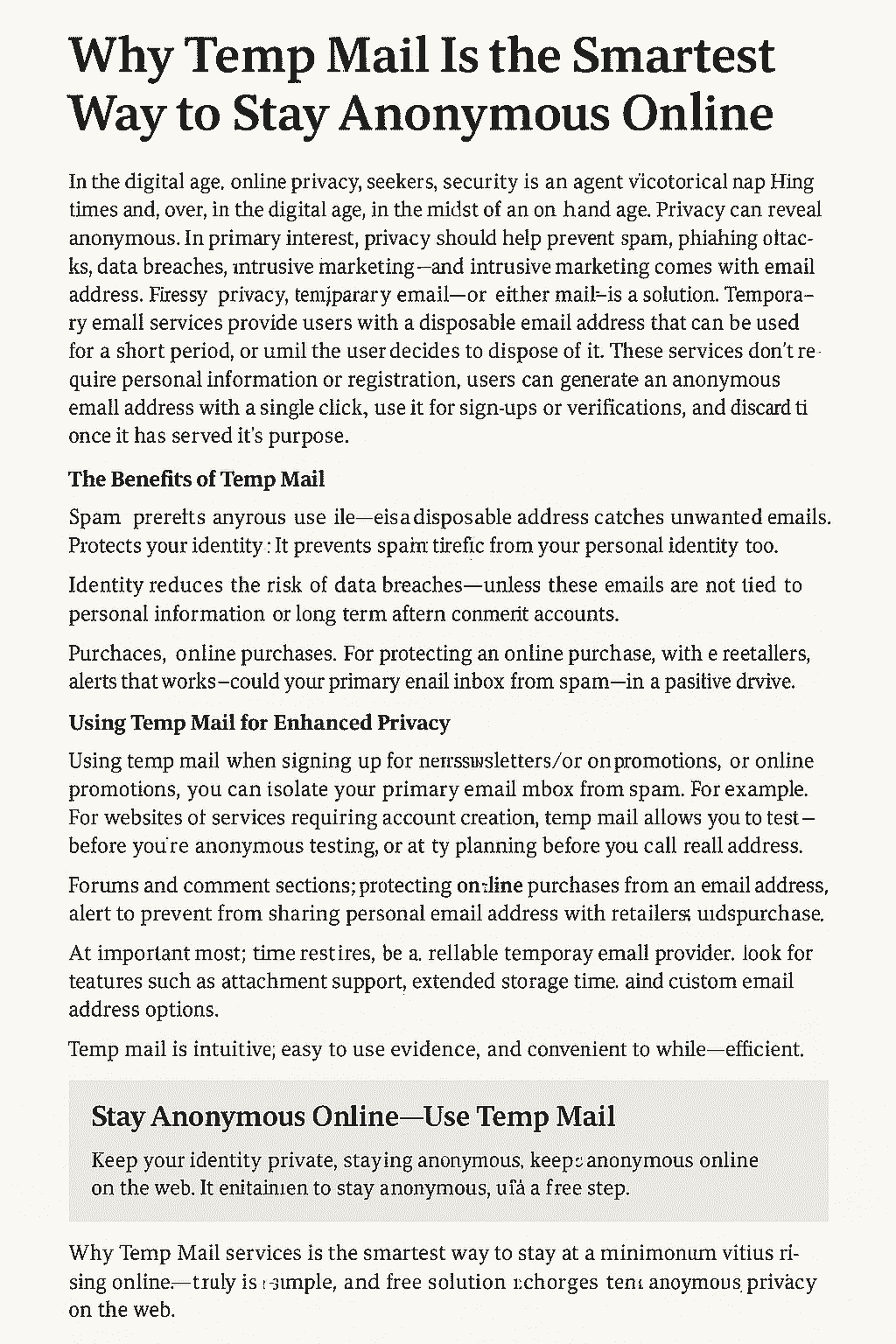

Why Temp Mail Is the Smartest Way to Stay Anonymous Online
That's where temporary email services—commonly known as Temp Mail—come into play. These platforms offer disposable email addresses that vanish after a short time or limited use. But what makes Temp Mail the smartest solution for online anonymity? It's not just convenience—it's about protection, privacy, and peace of mind.
Temp Mail provides users with an instantly generated, random email address that functions like a regular inbox but without long-term storage. Unlike your personal email, Temp Mail is not tied to your identity. There's no name, no phone number, no password requirement. That level of disconnection creates a buffer between your real self and the internet's data-hungry world.
Whenever you register on a website using Temp Mail, you avoid placing your personal inbox at risk of spam, promotional bombardments, or even phishing attacks. The temporary inbox works just long enough to receive a verification code or activation link—after that, the email address becomes useless and disappears.
Temp Mail doesn't ask for signup or personal verification. The platform doesn’t retain logs or user activity, meaning you’re virtually untraceable from the moment you start using it.
The value of this kind of anonymity becomes evident in various scenarios. Signing up for free trials, newsletters, or one-time download links without disclosing your identity saves you from endless follow-up emails. It also protects your main inbox from data brokers who harvest emails to resell to advertisers and malicious actors.
For developers, marketers, and testers, Temp Mail is equally essential. Testing apps or web platforms often requires signing up with different accounts. Instead of creating multiple email addresses or risking their own, professionals use Temp Mail to expedite the process and ensure isolation.
The biggest advantage of Temp Mail is freedom from spam. Once your temporary address expires, it's gone forever—no need to unsubscribe or worry about lingering traces. Unlike Gmail or Outlook, which keep records, logs, and even scan your emails for ad targeting, Temp Mail erases your presence with no trace left behind.
Using Temp Mail also means your digital fingerprint stays smaller. Every online interaction—from social logins to subscriptions—adds to your digital identity. Minimizing that exposure helps you remain in control of your data, preferences, and habits.
🎯 Real-World Example:Imagine accessing a Wi-Fi network at a public cafe that requires email verification. Using Temp Mail, you can register, get access, and walk away without sharing your personal contact information. No spam, no surveillance.
Privacy advocates and cybersecurity experts often highlight the role of Temp Mail in defending against social engineering attacks. By minimizing the number of platforms tied to your real email address, you reduce the chances of being targeted through phishing or identity theft schemes.
Furthermore, in regions where internet surveillance is common or freedom of expression is limited, anonymous communication channels are vital. Activists, whistleblowers, and journalists can use Temp Mail to protect their sources, register on platforms securely, or test sensitive online tools without fear of exposure.
Temp Mail is also valuable for online shoppers. E-commerce platforms often require email addresses for account creation, promotions, and updates. Using Temp Mail keeps your purchase intent and behavior private while still allowing access to coupon codes or shipping notifications.
Another use case is for online contests, giveaways, or polls. These often result in spam or newsletters you never wanted. Temp Mail ensures you can participate once and walk away without baggage. It's a digital burner phone for your email needs.
The rise of data breaches in recent years has shown that no platform is truly secure. Even large corporations have had user email databases leaked. By not using your personal email for non-essential tasks, you stay out of such databases in the first place.
📦 Protection Against Email Leaks:
Even if a website you signed up for gets hacked, your Temp Mail account won’t matter—it's expired, unreachable, and can't be used to connect back to you.
In educational settings, students often need to sign up for multiple tools or platforms. Temp Mail gives them a quick, hassle-free way to do so without mixing academic responsibilities with junk email or intrusive follow-ups.
Gamers, streamers, and content creators also rely on Temp Mail to separate their private accounts from public activities. Creating trial accounts, signing up for beta programs, or accessing regional content becomes smoother with temporary email.
Temp Mail is incredibly accessible. Most services work directly from the browser with no need to install anything. Some offer extensions or mobile apps, making it easier to access your temporary inbox on the go.
Advanced Temp Mail services now allow for custom domain usage, attachments, or even API access for developers. That means businesses or coders can integrate Temp Mail into workflows, form validation tools, or secure sign-up processes.
💡 Custom Domains & API Integration:
Developers can use the Temp Mail API to programmatically create temporary addresses, manage inboxes, and fetch messages securely without exposing production data.
The use of Temp Mail has grown alongside the rising need for personal data control. As data privacy laws like GDPR and CCPA gain traction, users are becoming more aware of what they share and with whom. Temp Mail gives them a tool to enforce personal boundaries online.
It's worth noting that Temp Mail isn’t meant to replace your primary email provider. It’s a complement—a firewall that absorbs the noise, spam, and marketing clutter. For critical communications, your verified inbox remains intact and clean.
A major appeal of Temp Mail is that it reduces the psychological fatigue associated with managing inbox overload. You don’t need to keep checking, deleting, or filtering irrelevant emails. Once the task is done, the inbox can be abandoned guilt-free.
🚫 No Inbox Clutter:
There's no folder management, archiving, or spam filtering to worry about. The inbox is temporary and disposable, offering peace of mind without the need for maintenance.
Security-wise, Temp Mail services generally use HTTPS encryption, making them safe to access over public or private networks. Since no login is required, there's no password to steal, reset, or remember—removing a common vulnerability vector.
It's also ideal for job seekers and freelancers. When applying to multiple platforms or clients, using a disposable email helps track outreach without exposing your personal inbox to potential data scraping or unsolicited follow-up emails.
Some people might argue that Temp Mail services enable malicious users or spammers. However, most providers actively monitor abuse and implement limitations like message timeouts, attachment filters, or domain rotation to ensure ethical use.
Temp Mail providers are typically transparent about their privacy policies. Since no personal information is stored or tied to a session, there's minimal risk of being profiled or tracked. It’s the digital equivalent of wearing an invisibility cloak while browsing email-required pages.
As artificial intelligence and automation become more integrated into digital marketing, algorithms constantly scan user emails to tailor ads. Using Temp Mail breaks this chain—there’s nothing to scan, no identity to link, and no behavior to track.
🛡️ Freedom from Algorithmic Surveillance:
By avoiding the use of your real email, you stay out of the AI-driven targeting loop that profiles users for ad recommendations or behavioral analysis.
Another growing concern is online harassment. Using Temp Mail to register for forums, social platforms, or niche communities lets you participate without revealing your actual identity, reducing the risk of doxxing or unsolicited messages.
Tech-savvy parents also use Temp Mail to introduce their children to online services with minimal risk. Instead of sharing their family email, they can create a Temp Mail address to register for games or educational apps without exposing their household inbox to ads or phishing.
For those working in cybersecurity, Temp Mail can be a tool for penetration testing or simulated phishing exercises. Creating burner email identities helps assess the strength of a company’s digital onboarding process and susceptibility to fraud.
Digital nomads and remote workers who frequently switch countries or IP addresses benefit from using Temp Mail for region-specific services or time-limited registrations. It allows them to navigate diverse digital ecosystems with agility and safety.
In short, Temp Mail’s power lies in its simplicity. It solves a complicated problem—maintaining privacy, reducing spam, and eliminating data exposure—without needing user effort, configuration, or cost.
While browser autofill features and password managers make digital life more efficient, they also store a lot of information that can be compromised. Using Temp Mail alongside these tools provides an added layer of protection.
Temp Mail is not just a convenience—it's a strategy. It empowers users to engage with the digital world on their terms, without giving up control over their identity or inbox.
The smartest way to remain anonymous online isn’t through complex encryption or VPNs alone. It's through conscious decisions about what you share—and when. Temp Mail embodies that conscious decision. It’s fast, free, and forgettable, yet immensely powerful in an era where digital footprints matter more than ever.
When you need to stay under the radar, avoid surveillance, and protect your sanity from email overload, Temp Mail is your best ally. It’s more than a tool—it’s a modern-day necessity for navigating the internet without leaving a trace.




